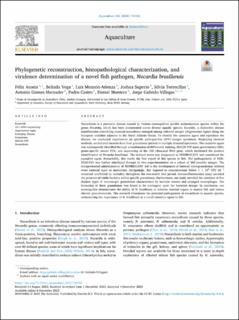| dc.contributor.author | Acosta, Félix | |
| dc.contributor.author | Vega, Belinda | |
| dc.contributor.author | Monzón-Atienza, Luis | |
| dc.contributor.author | Superio, Joshua Lustracion | |
| dc.contributor.author | Torrecillas, Silvia | |
| dc.contributor.author | Gómez-Mercader, Antonio | |
| dc.contributor.author | Castro, Pedro | |
| dc.contributor.author | Montero, Daniel | |
| dc.contributor.author | Galindo-Villegas, Jorge | |
| dc.date.accessioned | 2023-12-28T12:45:40Z | |
| dc.date.available | 2023-12-28T12:45:40Z | |
| dc.date.created | 2023-12-05T10:48:24Z | |
| dc.date.issued | 2023 | |
| dc.identifier.citation | Acosta, F., Vega, B., Monzón-Atienza, L., Superio, J. L., Torrecillas, S., Gómez-Mercader, A., Castro, P., Montero, D. & Galindo-Villegas, J. (2024). Phylogenetic reconstruction, histopathological characterization, and virulence determination of a novel fish pathogen, Nocardia brasiliensis. Aquaculture, 581: 740458. doi: | en_US |
| dc.identifier.issn | 1873-5622 | |
| dc.identifier.uri | https://hdl.handle.net/11250/3109028 | |
| dc.description.abstract | Nocardiosis is a prevalent disease caused by various cosmopolitan aerobic actinomycetes species within the genus Nocardia, which has been documented across diverse aquatic species. Recently, a distinctive disease manifestation resembling classical nocardiosis emerged among cultured meagre (Argyrosomus regius) along the European coastline adjacent to the North Atlantic Ocean. To identify the causative agent and reproduce the disease, we conducted experiments on specific pathogen-free (SPF) meagre specimens. Employing classical methods, we isolated bacteria from liver granulomas present in multiple diseased specimens. The causative agent was subsequently identified through a combination of differential staining, MALDI-TOF mass spectrometry (MS), genus-specific nested PCR, and sequencing of the 16S ribosomal RNA gene, which facilitated the positive identification of Nocardia brasiliensis. The isolated strain was designated as NORBRACAN1 and considered the causative agent. Remarkably, this marks the first report of this species in fish. The pathogenicity of NORBRACAN1 was further elucidated through in vivo experimentation on a cohort of 360 juvenile meagre. The intraperitoneal administration of NORBRACAN1 led to the development of internal microgranulomas without overt external signs or mortalities. Intriguingly, fish exposed to concentrations below 1 × 106 CFU mL−1 remained unaffected by mortality throughout the two-month trial period. Immunofluorescence assay unveiled the presence of viable bacteria within specific granulomas. Furthermore, our study unveiled the existence of five distinct types of microscopic granulomas characterized by necrotic centers and arranged macrophages. The formation of these granulomas was found to be contingent upon the bacterial dosage. In conclusion, our investigation demonstrates the ability of N. brasiliensis to colonize internal organs in marine fish and induce chronic granulomatosis. This research illuminates the potential pathogenesis of nocardiosis in aquatic species, underscoring the importance of N. brasiliensis as a novel causative agent in fish. | en_US |
| dc.language.iso | eng | en_US |
| dc.publisher | Elsevier | en_US |
| dc.rights | Navngivelse 4.0 Internasjonal | * |
| dc.rights.uri | http://creativecommons.org/licenses/by/4.0/deed.no | * |
| dc.title | Phylogenetic reconstruction, histopathological characterization, and virulence determination of a novel fish pathogen, Nocardia brasiliensis | en_US |
| dc.type | Peer reviewed | en_US |
| dc.type | Journal article | en_US |
| dc.description.version | publishedVersion | en_US |
| dc.rights.holder | © 2023 The Author(s) | en_US |
| dc.source.pagenumber | 11 | en_US |
| dc.source.volume | 581 | en_US |
| dc.source.journal | Aquaculture | en_US |
| dc.identifier.doi | 10.1016/j.aquaculture.2023.740458 | |
| dc.identifier.cristin | 2209022 | |
| dc.source.articlenumber | 740458 | en_US |

